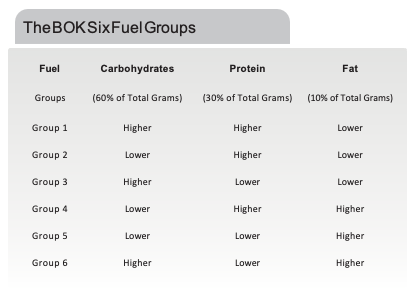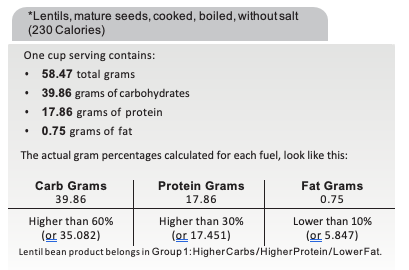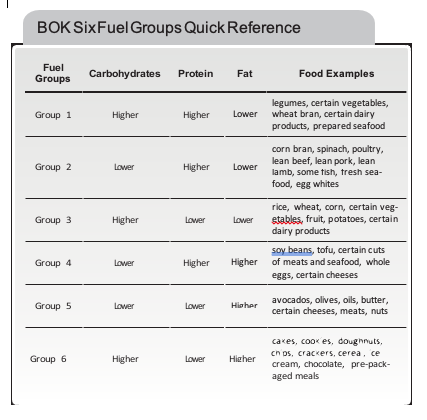This system is your guide to making intelligent choices and keeping track of the ratios you choose. The fuel group order does not reflect an absolute hierarchy, although groups1, 2, and 3 are all lower in fat and group 6 contains most of the unhealthy processed food items.This design not only simplifies your long-term goals, it also makes shopping, cooking, and ordering in restaurants much easier too.
Simply put, weight loss, especially fat loss, is influenced by the mixture and proportions of protein, carbohydrates, and fats, plus the total number of calories eaten each day.
You learned about that in Principle No. 1 – How Much to Eat. It is also influenced by the size of a meal, the frequency of your meals, and the effect your food selection has on insulin secretion. You learned about that in Principle No. 2 – How Often to Eat.Principle No. 3 – What to Eat; helps the first two work together more efficiently, and the three combined work to produce the best results in a simplistic way. It is so easy, in fact, that before long this knowledge will become second nature.All foods contain some proportion of the three fuels. There are a few foods that contain nearly equal proportions of the three, but most foods are dominant in only one or two fuels.
This food classification system uses the BOK Fat Loss/Weight MaintenanceMeal Plan percentages (60 percent carbohydrate, 30 percent protein, and 10 percent fat of total grams per food item) as a standard, and uses the terms higher and lower to indicate whether the fuels exist in larger or smaller percentages than their standard percentages. It also takes into consideration total calories and the general chemical composition of individual foods. This naturally breaks food into six unique subsets based on their carb-to-protein-to-fat calorie ratios.
Each of the six groups can also be separated into processed and unprocessed categories. For our purposes, processed is defined as any alteration in the natural form of the food item and unprocessed is defined as the unaltered form, but also includes cooked items and pasteurization (dairy products). For example, black beans (unprocessed) are healthy, cooking and canning them does not make them unhealthy. Adding salt, fats, and preservatives to the beans during the processing is what makes certain brands less healthy.
Class Distinction
Here is how foods fit into the Six Fuel groups: Each of the six groups contains individual food items that fit into the range of protein, carbohydrate, and fat percentages.
The percentage range for each fuel uses the Fat Loss/Weight Maintenance Meal Plan percentages as a standard reference—60 percent carbohydrate,30 percent protein, and 10 percent fat of total grams for each food item.
The terms higher and lower describe which side of the standard reference range the amount of carbs protein, and fat are for each food item in each fuel group.
Higher: food in grams that are more than 60 percent carbohydrate, 30 percent protein or 10 percent fat
Lower: food in grams that are less than 60 percent carbohydrate,30 per- cent protein, or 10 percent fat



Fuel Groups 1, 2, and 3 are the most diet-friendly, simply because they are lower in fat. They should be considered your new comfort foods, meaning that you can feel comfortable eating from these three groups at will as long as you stay within your calorie limits and focus on unprocessed foods.
Groups 4 and 5 also have healthy choices, but keep your portions smaller in these two groups and limit the processed varieties.Group 6 contains the foods with the greatest fat-gaining potential. You may or may not choose to completely avoid them, but at least you will know what they are and what they contain. Don’t think for a minute that you will be restricted in your food choices.
As long as you stick to the BOK ThreePrinciples of Eating, you will reach your goals. Even if you choose to stay focused and eat foods only from the first three groups, the number and variety of foods is very large – proof perfect of Mother Nature’s superb planning skills. Let’s explore the fuel groups and what they offer.
Fuel Group 1
Carbohydrates—Higher (than 60% total grams)
Protein—Higher (than 30% total grams)
Fat—Lower (than 10% total grams)
When looking for low fat foods that are closer to a 2 to 1 ratio of carbs- to-protein, you should focus on Group 1. Eat these at will as long as you are within your calorie count. Group 1 foods include, but are not limited to, nonfat dairy products, legumes (black beans, kidney beans, etc.), and vegetables (asparagus, broccoli, cauliflower, etc.). Consider a typical serving size to be about one-half cup for legumes, one-half to one cup for vegetables, and 8 ounces for nonfat milk products.
Fuel Group 2
Carbohydrates—Lower (than 60% total grams
Protein—Higher (than 30% total grams)
Fat—Lower (than 10% total grams)
Group 2 is where you will find most meats, fish, shellfish, and a few dairy products.These are your ideal proteins for weight maintenance because they are leaner varieties. This is also the group to turn to when you see your carbohydrate count for the day getting high. Carbs are hard to avoid because they are in so many foods. That’s why I love this group; it helps counter the heavy carb days.
Return to this group as needed to meet your protein requirements while keeping fat intake low. Common foods in this group are most types of beef, fish, poultry, game meats, egg whites, low fat or nonfat dairy products, and supplemental varieties of protein(soy and whey). Appropriate serving sizes are 3 ounces for meat and fish, 1/2cup for egg whites, 8 oz. for low fat milk or fortified nonfat milk, 4 oz. for cottage cheese, and 1 oz. for cheese. If you are following either the 1:1 or2:1 ratio plan, feel free to eat in this group at will, add carbs thoughtfully, and stay within your daily calorie count.
Fuel Group 3
Carbohydrates —Higher (than 60% total grams)
Protein—Lower (than 30% total grams)
Fat—Lower (than 10% total grams)
Group 3, the high carb family, by far contains the largest food selection. This is where you’ll find breads, pastas, rice, cereals, crackers, pancakes, and waffles, as well as lowfat and non-fat desserts, such as cakes, cookies, ice cream, and candy. Because these foods are usually higher in simple carbohydrates, you need to approach this group with a little caution.
Excess carbs, especially eaten in one sitting, release more insulin which can turn off the body’s fat-burning mechanism and turn on the fat storage—a situation you want to avoid. This means that even though these foods are low in fat, eating a lot of them at once can create a fat-storage friendly environment in your body no matter what you eat with them.
The best way to minimize this risk is to opt for unprocessed, complex, quality carbs (such as fruits, vegetables, legumes, and whole grains) or keep your servings smaller and include protein, fat, or other complex carbo- hydrates in your meals or snacks. Serving sizes in this group are one slice for breads, and 1/2 to 1 cup for pastas, rice, cereals, fruits, and vegetables.
Fuel Group 4
Carbohydrates—Lower (than 60% total grams)
Protein—Higher (than 30% total grams)
Fat—Higher (than 10% total grams)
This group contains a lot of good protein, but it crosses the line into higher fat.Notice that this group is not just limited to meats. Cheeses, 2% milk, low fat yogurt, and whole eggs have more fat than groups 1 or 2 and more often a higher saturated to unsaturated ratio.Soy products have their share of fat, too, though it is unsaturated. Still, when it comes to burning fuel, fat is fat. Plan these foods in your day carefully so that you do not exceed your fat ratio limit.
They are not off-limits in any eating program, just remember to keep them in the “occasional” category. The caveat “everything is good in moderation” applies here.
Fuel Group 5
Carbohydrates—Lower (than 60% total grams
Protein—Lower (than 30% total grams)
Fat—Higher (than 10% total grams)
This group is made up of foods that are mostly or purely fat. Nuts, seeds, nut butters, salad dressings, butter, lard, mayonnaise, certain cheeses, a variety of luncheon meats, and oils all fall into this category. Here, the serving sizes should never go beyond ounces, teaspoons, or tablespoons. I still believe that nothing should be totally off-limits; however, foods in this group during a weight management plan should be eaten sparingly (somewhere around the suggested 10% gram weight and 25% calories).
As you know, not all fats are created equal.
Fats can be grouped into unsaturated fats(which include monounsaturated and polyunsaturated) and saturated fats.Unsaturated is always the best choice. Monounsaturated fats have shown better protection for heart disease, but other polyunsaturated fats are also very healthy.
The foods listed in this fuel group either have two or three types of fat. Almost all plant oils have more mono and polyunsaturated fats, while animal oils are generally higher in saturated fats. For example, olive oil contains more monounsaturated than polyunsaturated than saturated fats.
Fuel Group 6
Carbohydrates—Higher (than60% total grams)
Protein—Lower (than 30% total grams)
Fat—Higher (than 10% total grams)
A high-fat, high-carbohydrate, low-protein combination is a perfect scenario for fat storage. Such a formula exists in Mother Nature only where weight gain is appropriate, such as in whole milk for growing youngsters. Most of the remain- ing food items in this fuel category are designed by man, which means many of them are processed and contain added salt which is another contributor to fat storage.
Obviously, this combination constitutes a vast majority of the processed and packaged foods available today. This list could go on and on, but I will keep it simple.Included here are some of the more popular foods, some of which may surprise you. You do not want your fuel mix at the end of the day to add up to this combination, so select these foods sparingly, or not at all.

Sugar may be the most abused legalized drug on the planet, but alcohol runs a close second. Not surprising, since both are processed from natural carbohydrates.There are differences, though, in how the body processes alcohol com- pared to other carbohydrates. First, alcohol contains seven calories per gram, not four or nine calories per gram, so it is somewhere between a fat and a carbohydrate in its caloric content.
Second, the insulin response is high since most alcoholic beverages (beer, wine, margaritas, etc.) contain simple and other processed carbohydrates with a higher glycemic index. Third, alcohol is the epitome of “empty calories”—totally devoid of any vitamins, minerals or nutritional value. It contributes no health value to the body, so it quite literally sloshes around in your bloodstream while it does funny things to your brain that can promote fat storage. Drinking alcohol and eating improperly often go hand-in-hand - the perfect scenario for fat production.
Even just a few drinks will culminate in a sugar crash, which will quite often lead to alate-night binge. And this brings us to the final negative effect—alcohol’s effect on the central nervous system. You don’t have to get rip-roaring drunk to initiate this problem; you can just sip your way to what is called“disinhibition.”Once you have a drink or two, logical thinking can become clouded.
Disinhibition and alcohol sugar are a powerful combination that will work against your goals. Once you have disinhibited your intelligent, healthy, good intentions with enough alcohol, your primitive instincts takeover— the ones that tell you to eat like there is no tomorrow. On the other hand, recent research supports the idea that one to two glasses of wine a day promotes good cardiovascular health. At an average of 100 calories per glass, this moderate amount should not affect your weight.
Keep alcohol in the occasional category if you are on the BOK Fat Loss/Weight Maintenance Meal Plan, and try to avoid it as much as possible if you are on the BOK Accelerated WeightLoss Meal Plan.

